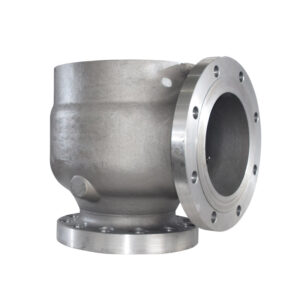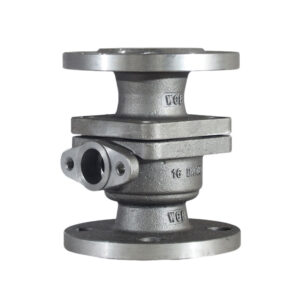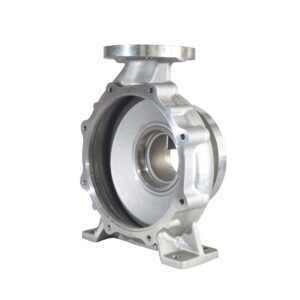Cuerpo de la válvula de retención
Cuerpo de la válvula de retención
El Cuerpo de la válvula de retención Es un componente esencial para uso civil, diseñado para garantizar un control de fluidos eficiente y fiable en sistemas residenciales y comerciales. Fabricado para ofrecer durabilidad y precisión, el cuerpo de la válvula de retención proporciona un rendimiento óptimo al prevenir el reflujo y mantener la integridad del sistema. Con la confianza tanto de profesionales como de particulares, es la opción ideal para soluciones integrales de gestión de fluidos.
El Cuerpo de la válvula de retención es un componente estructural central en sistemas de control de fluidos, específicamente diseñados para garantizar flujo unidireccional y evitar el flujo inverso en una amplia gama de civil, residencial y comercial aplicaciones. Diseñado para su uso en tuberías de agua potable, circuitos de climatización, sistemas de riego y sistemas de drenaje de servicios públicos, el Cuerpo de la válvula de retención juega un papel clave en Preservar la presión del sistema y protección de bombas, medidores y válvulas por posibles daños por reflujo.
Elaborado con materiales de alta resistencia a la corrosión, el Cuerpo de la válvula de retención está mecanizado con precisión para ofrecer rendimiento de sellado excepcional y estabilidad mecánica a largo plazo. Su geometría interna está optimizada para reducir la resistencia al flujo al tiempo que garantiza una respuesta de cierre rápida y fiable bajo condiciones de presión inversa. Tanto en instalaciones verticales como horizontales, el diseño garantiza baja presión de agrietamiento y una mínima pérdida de energía.
La flexibilidad de instalación es otra ventaja: compatible con una amplia gama de componentes internos de válvulas, asientos de elastómero y tipos de conexión. Cuerpo de la válvula de retención Puede integrarse sin problemas tanto en configuraciones de tuberías antiguas como modernas. También es adecuado para sistemas que operan bajo diferentes rangos de presión, ciclos de temperatura o patrones de flujo intermitentes, manteniendo la integridad del sistema incluso en entornos dinámicos.
Cada Cuerpo de la válvula de retención se somete protocolos estrictos de garantía de calidad, Incluye verificación dimensional, pruebas de presión y certificación de materiales para cumplir con los estándares de la industria y las expectativas de los usuarios. Este componente, que goza de la confianza de ingenieros civiles, fontaneros y equipos de mantenimiento de instalaciones, es un Opción ideal para una prevención de reflujo robusta y sin mantenimiento en sistemas de transporte de fluidos.
- Más de 60 tipos de materiales, más de una docena de aleaciones y 70 tipos de números.
- Se pueden producir muchos productos, más de 3500 moldes de fundición de precisión y más de 1000 moldes de fundición en arena.
- Los accesorios de producción pueden ser grandes o pequeños.
- Se puede personalizar un solo producto de 50 kg.
- Hay varios hornos disponibles para seleccionar y se pueden producir piezas individuales de 50 kg a 850 kg.
- Con 20 años de experiencia y maestría, ingresó a la industria en la década de 1980 y se convirtió en el líder de la industria.
- Los productos son trazables y cada producto de horno tiene un certificado: 3.1 Certificado de material.
- Los clientes pueden solicitar a una agencia de pruebas de terceros que emita un certificado 3.2.
- Los productos de primera calidad procesados pueden ser objeto de un certificado de procesamiento.
Ventajas de Leierwo en la fundición de piezas de precisión en la industria de fundición de válvulas
Leierwo lleva muchos años inmerso en el sector de la fundición de precisión, acumulando una amplia experiencia en la fabricación de componentes para válvulas. La empresa se especializa en la producción de piezas fundidas de precisión de acero al carbono, acero aleado y acero inoxidable, materiales comunes en la industria de las válvulas. Mediante tecnologías avanzadas como la fundición por fusión y los procesos de sol de sílice, la empresa logra el moldeo de alta precisión de piezas estructurales complejas, cumpliendo con los requisitos de rendimiento de las válvulas en condiciones de funcionamiento de alta temperatura, alta presión y resistencia a la corrosión. Además, Leierwo prioriza la producción a medida según los planos del cliente, lo que le permite adaptar mejor las piezas fundidas de las válvulas a las necesidades específicas del cliente, garantizando así el sellado y la estabilidad estructural del producto.
Selección del material principal
Las piezas fundidas para válvulas deben soportar condiciones de operación complejas, como presión, temperatura y corrosión. Por lo tanto, la selección del material debe priorizar la resistencia a la corrosión, la resistencia a altas temperaturas, la resistencia a la cavitación y una buena procesabilidad. El acero inoxidable es la opción preferida debido a su excelente rendimiento general.
Materiales comunes:
Serie de acero inoxidable:
316/316L: La mejor opción, resistente a la corrosión de iones de cloruro, adecuado para entornos marinos, industrias químicas y petroleras. 304/304L: Un material económico adecuado para entornos corrosivos generales. 410: Acero inoxidable martensítico, con cierta resistencia a la corrosión, adecuado para válvulas de vapor de alta temperatura.
17-4PH: Acero inoxidable endurecido por precipitación, de alta resistencia y resistencia a la corrosión, adecuado para válvulas de alto rendimiento.
Serie de acero al carbono:
WCB (material general de acero al carbono): se utiliza comúnmente para válvulas de uso general a temperatura ambiente.
4130: Adecuado para carcasas de válvulas de alta temperatura y alta presión.
Serie de aleaciones especiales (para entornos de alta corrosión y alta temperatura): Acero inoxidable dúplex 2205: Excelente resistencia a la corrosión bajo tensión, ideal para las industrias marina y química. Aleación de cobalto (CoCr): como Co6 y Co12, ideal para superficies de sellado de válvulas con daños severos por alta temperatura.
Opciones de servicio de casting de claves
Las válvulas tienen requisitos estrictos de sellado y resistencia a la presión, y la elección del servicio de fundición afecta directamente su confiabilidad funcional:
Fundición a la cera perdida: El método preferido para válvulas de media y alta presión. Componentes como cuerpos de válvulas y asientos de sellado suelen contener cavidades internas complejas (como trayectorias de flujo curvas) y superficies de contacto precisas (p. ej., la rugosidad de la superficie de sellado debe ser ≤ Ra1,6 µm). La fundición a la cera perdida permite replicar con precisión formas complejas, reducir defectos de fundición (como poros y retracciones) y mitigar el riesgo de fugas. Es especialmente adecuada para válvulas de alta presión de acero inoxidable y aleaciones.
Fundición en arena: Adecuada para la producción en masa de válvulas de baja presión y gran escala. Por ejemplo, los cuerpos de válvulas de compuerta de baja presión para el suministro de agua municipal tienen formas relativamente simples (principalmente estructuras simétricas), grandes tiradas de producción y requisitos de precisión moderados. La fundición en arena ofrece ventajas significativas en términos de bajo costo y alta capacidad de producción.
Mecanizado CNC: Se centra en las zonas de contacto críticas. Las bridas de la válvula y los diámetros del eje del vástago deben alinearse con precisión con la tubería o el actuador. Tras la fundición, se realizan fresados y rectificados CNC para garantizar tolerancias de planitud y perpendicularidad de ≤0,02 mm/m, garantizando así un ensamblaje hermético.





